
Styphelia is a genus of shrubs in the family Ericaceae and is endemic to Australia. Most have minute or small leaves with a sharp tip, single, tube-shaped flowers arranged in leaf axils and with the ends of the petals rolled back with hairs in the inside of the tube.
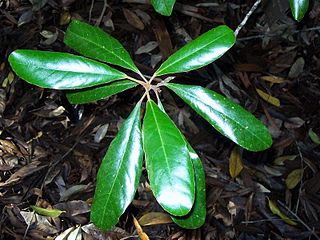
Elaeocarpus williamsianus, commonly known as hairy quandong, is a species of flowering plant in the family Elaeocarpaceae and is endemic to a restricted area of north-eastern New South Wales. It is a small tree with lance-shaped leaves, racemes of greenish-white flowers and spherical blue fruit.

Prostanthera cryptandroides is a species of flowering plant in the family Lamiaceae and is endemic to eastern Australia. It is a low, spreading shrub with narrow egg-shaped leaves and lilac to mauve flowers arranged singly in leaf axils.

Persoonia acerosa, commonly known as needle geebung, is a species of flowering plant in the family Proteaceae and is endemic to a restricted area of New South Wales. It is a shrub with small, channelled, needle-like leaves, yellow tubular flowers and yellowish-green, pear-shaped fruit.

Persoonia bargoensis, commonly known as the Bargo geebung, is a species of flowering plant in the family Proteaceae and is endemic to a restricted area of New South Wales. It is an erect shrub with linear to lance-shaped leaves, yellow, tube-shaped flowers and green, pear-shaped fruit.
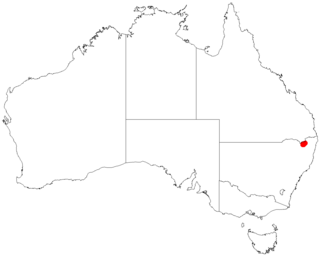
Prostanthera staurophylla, commonly known as Tenterfield mint-bush, is a species of flowering plant in the family Lamiaceae and is endemic to a small area on the New England Tableland of New South Wales. It is an erect to spreading, strongly aromatic shrub with hairy branches, deeply lobed leaves and bluish-mauve flowers with darker markings.
Eremophila virens, commonly known as green-flowered eremophila or Campion eremophila, is a flowering plant in the figwort family, Scrophulariaceae and is endemic to Western Australia. It is an erect shrub with large, shiny leaves and hairy, yellowish-green flowers.

Asterolasia elegans is a species of slender, erect shrub that is endemic to a restricted area of New South Wales. It has dense, woolly, rusty star-shaped hairs on its stems, lance-shaped leaves densely covered with white and rust-coloured hairs on the lower surface, and white flowers arranged singly or in groups of up to nine in leaf axils or on the ends of branchlets, the back of the petals densely covered with woolly, white hairs.

Homoranthus binghiensis is a flowering plant in the family Myrtaceae and is endemic to a small area in northern New South Wales. It is an upright shrub with pointed leaves and usually paired yellowish to red flowers.
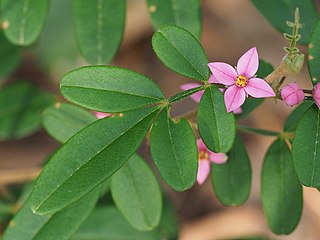
Boronia umbellata, commonly known as the Orara boronia, is a plant in the citrus family Rutaceae and is endemic to a small area on the north coast of New South Wales. It is an erect shrub with many branches, aromatic, pinnate leaves and clusters of up to ten dark pink flowers in the leaf axils.
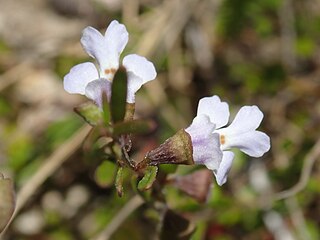
Prostanthera junonis, commonly known as Somersby mintbush, is a species of flowering plant in the family Lamiaceae and is endemic to the Central Coast of New South Wales. It is a low, straggling shrub with hairy, egg-shaped leaves and purple to mauve flowers.

Prostanthera askania, commonly known as tranquility mintbush, is a shrub that is endemic to Australia. It has mostly pale mauve flowers, strongly scented leaves and branches, dull green, toothed egg-shaped leaves and a restricted distribution.

Leptospermum thompsonii, commonly known as the monga tea-tree, is a species of tall shrub that is endemic to south eastern New South Wales. It has rough, flaky bark, broadly elliptical to egg-shaped leaves with the narrower end towards the base, and a sharply-pointed tip, white flowers and fruit that remains on the plant at maturity.

Phebalium speciosum is a species of shrub that is endemic to a restricted area of New South Wales. It has branchlets covered with rust-coloured scales, lance-shaped to narrow elliptical leaves covered with silvery and rust-coloured scales, and umbels of white to pale pink flowers with silvery or rust-coloured scales on the back of the petals.

Prostanthera gilesii is a species of flowering plant in the family Lamiaceae and is endemic to the Mount Canobolas area of New South Wales. It is a small, compact, spreading shrub with aromatic, narrow egg-shaped to elliptical leaves, and white to yellowish white flowers with purple to dark mauve markings inside the petal tube and pale orange markings on the petal lobes.
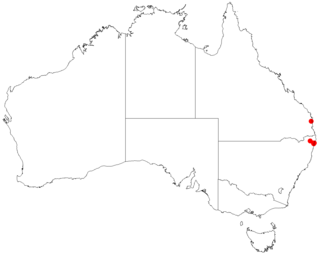
Prostanthera palustris, commonly known as swamp mint-bush, is a species of flowering plant in the family Lamiaceae and is endemic to a restricted area of New South Wales. It is a low, spreading, weak shrub with spatula-shaped leaves and pale mauve and white flowers with yellow spots in the petal tube.
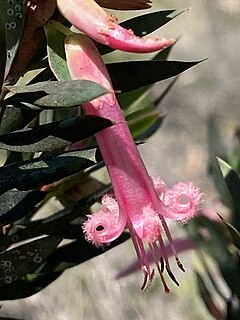
Styphelia triflora, commonly known as pink five-corners, is a flowering plant in the heath family Ericaceae. It is an erect, spreading shrub with broad leaves with a spiky tip, and usually pink tubular flowers with the petals rolled back. It is found in New South Wales and Queensland growing on loam or sandy soils.
Pultenaea elusa, commonly known as elusive bush-pea, is a species of flowering plant in the family Fabaceae and is endemic to a small area of New South Wales. It is a low shrub with sharply-pointed linear leaves, and dense clusters of yellow to orange and red to purple flowers. It has not been seen since 1938.

Pultenaea fragrans is a species of flowering plant in the family Fabaceae and is endemic to a small area of New South Wales. It is an erect shrub with flattened cladodes, small, scale-like leaves, and pea-like, yellow and red flowers.
Bossiaea oligosperma, commonly known as few-seeded bossiaea, is a species of flowering plant in the family Fabaceae and is endemic to eastern New South Wales. It is an erect shrub with broadly egg-shaped to more or less round leaves with a small point on the tip, and yellow and red flowers.



















